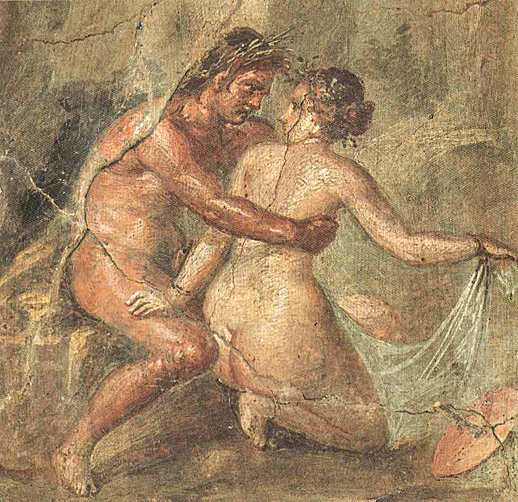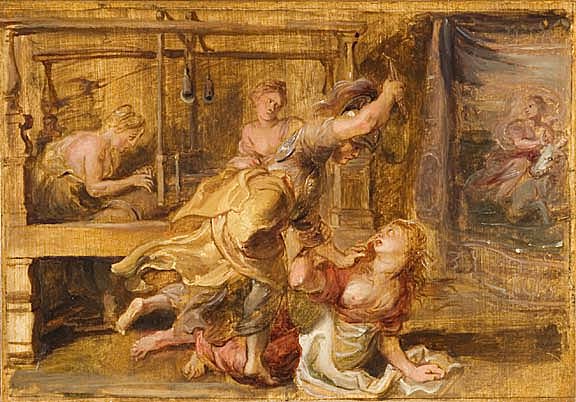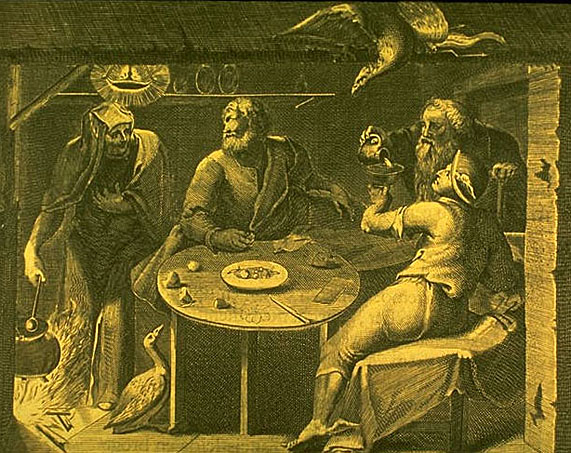

Ovid whose full name was Publius Ovidius Naso was born on March 20, 43 B.C., at Sulmo (modern Sulmona) about 90 miles from Rome. His father, a member of the equestrian order, intended for him to become a lawyer and an official and gave him an excellent education, including study under the great rhetoricians Arellius Fuscus and Porcius Latro. According to Seneca Rhetor, he preferred the suasoriae, exercises in giving advice in various historical or imaginary circumstances, to the prescribed debates of the controversiae, and his orations seemed nothing but poems without meter. His facility in composition, the content of some of his poems, and the rhetorical nature of much of his work in general all reflect his training with the rhetoricians.
Ovid also studied in Athens, toured the Near East with his friend Macer the poet, and lived for almost a year in Sicily. His father, who frequently pointed out to him that not even Homer had made any money, then apparently prevailed upon him to return to Rome, where he served in various minor offices of a judicial nature; but he disliked the work and lacked further ambition, so he soon surrendered to a life of ease and poetry.

Early Works
Ovid's life in the years after his liberation was that of a poet and man-about-town. He moved in the best literary circles, although never forming part of either of the major coteries of the time, those around Messalla and Maecenas. He had attracted notice as a poet while still in school and in time came to be surrounded by a group of admirers of his own. Ovid's early work was almost all on the theme of love; the residue of this early production, after he had destroyed many poems which he considered faulty, formed three short books of verses known as the Amores (Loves): the earliest poem of this collection seems to be a lament for Tibullus, who died in 19 B.C., and the latest assignable date for any of these poems is about 2 B.C. Most of these poems concern Ovid's love for a certain Corinna, who is generally considered an imaginary figure: the poems addressed to her form an almost complete cycle of the emotions and situations which a lover might expect to undergo in a love affair. This interest in the psychology of love is also exemplified in his Heroides, which dates from roughly the same period and is a series of letters from mythical heroines to their absent husbands or lovers.
This period of Ovid's life seems to have been relatively tranquil as well as productive. Of his private life we know little. In addition to "other company in youth," he was married three times; the last marriage, apparently a very happy one, was to a relative of his patron Paullus Fabius Maximus, a man of great influence. By one of these wives he had a daughter who made him a grandfather. His parents died only shortly before he was suddenly relegated (a form of banishment without the loss of property or civil rights) in A.D. 9 or 8 to Tomi on the Black Sea (the modern Constantsa in Romania).

His Exile
The reasons behind Ovid's exile have been the subject of much speculation. He himself tells us that the reason was "a poem and a mistake." The poem was clearly his Art of Love. With this work, its companion piece, The Remedies for Love, on how to get over an unsuccessful love affair, and its predecessor, On Cosmetics, Ovid had invented a new kind of poetry, didactic and amatory. The Art of Love consists of three books which parody conventional love poetry and didactic verse while offering vivid portrayals of contemporary Roman society.
The witty sophistication of this work made it an immediate and overwhelming success in fashionable society and infuriated the emperor Augustus, who was attempting to force a moral reformation on this same society. To the Emperor, this work must have seemed, in the strictest sense, subversive, and he excluded it, along with Ovid's other works, from the public libraries of Rome. What the "mistake" may have been, we do not know. It was, Ovid says, the result of his having eyes, and the most widely accepted suggestion is that he had somehow become aware of the licentious behavior of the Emperor's daughter Julia (who was banished in the same year as he) without his informing Augustus about her.
Upon receiving word of his exile, Ovid dramatically burned the manuscript of his masterpiece, the Metamorphoses.
The unreality of this gesture can be seen from the fact that his friends already had copies and that he took the unfinished manuscript of his Fasti along with him into exile. The journey to Tomi lasted nearly a year, and when he arrived, he found it a frontier post, where books and educated people were not to be found and Latin was practically unknown. Tomi was subject to attack by hostile barbarians and to bitterly cold winters. The production of the last 10 years of his life consists largely of tedious and interminable complaints mingled with appeals for recall, in the Sorrows and Letters from the Black Sea, but Augustus was too bitterly offended to relent, and the accession of Tiberius in A.D. 14 brought an even more unyielding emperor to the throne.
Ovid's exile was not so unbearable as his letters indicate. He learned the native languages, and his unconquerable geniality and amiability made him a beloved and revered figure to the local citizens, who exempted him from taxes and treated him as well, he said, as he could have expected even in his native Sulmo. He wrote a panegyric to Augustus in the Getic language, the loss of which is a source of regret for philologists; a bitter attack on an unnamed and perhaps imaginary enemy, the Ibis; and a work on the fish of the Black Sea, the Halieutica; he resumed work on the Fasti before his death, which is given by St. Jerome as occurring in A.D. 17, but probably occurred early in the next year. Ovid's earliest work, in the Loves and Heroides, already exhibits his fully developed talent. His verse is facile, smoothly flowing, and rhetorical and artificial without ever being obscure or even very often giving the impression of being other than natural and inevitable. His mastery of Greek literature, from which he draws most of his themes and to which he is continually alluding by direct or indirect quotation, was very great. His faults are those of over facility and an occasional excessive verbal cleverness.

His Masterpiece
Ovid's masterpiece is generally considered to be his Metamorphoses. It is an epic in form, 15 books in length, and devoted to the theme of changes in shape, although some stories not strictly limited to this theme are included. It is arranged in chronological order from the creation of the world to the Apotheosis of Julius Caesar, the first 12 books being derived from Greek mythology, and books 13-15 devoted to Roman legends and history, beginning with the Story of Aeneas. The transitions between the various stories are managed with great skill.


The metamorphoses are of form only: the character, interests, and activities of the persons transformed remain invariable under transformation. Lycus, for example, in the first metamorphosis in book I, retains his savage cruelty when he is transformed into a wolf; Arachne, changed into a spider for daring to challenge Minerva to a contest in weaving, retains her skill and shows it in her webs; and Baucis and Philemon, transformed into trees, remain inseparable as they were in life and continue to offer hospitality with their shade as they did to Jupiter while they were still in human form. Above all, however, the Metamorphoses owes its preservation to the incomparable narrative skill with which Ovid takes the old tales of a mythology which by his time was already hackneyed, and as little an object of belief then as now, and imbues them with sensuous charm and freshness.
The Fasti was intended to be a Roman religious calendar in verse, one book for each month. Ovid completed only six books. It is of interest because it contains much antiquarian lore otherwise unknown (probably derived from the works of Marcus Verrius Flaccus, the greatest of Augustan scholars), chosen with Ovid's usual eye for the picturesque and versified with his usual elegance.
Several lost works of Ovid's are recorded, the most important being his tragedy Medea, a rhetorical closet drama like the tragedies of Seneca, which is highly praised by Quintilian and Tacitus. Some epigrams are ascribed to him, perhaps correctly.

Later Influence
In antiquity itself the influence of Ovid on all subsequent writers of elegiac and hexameter verse was inescapable, even for those writers who were consciously attempting to return to earlier, Virgilian standards; and his stories, particularly from the Metamorphoses, were a major source for the illustrations of artists.
In the Middle Ages, especially the High Middle Ages, when interest in Ovid's works was primarily centered on the Metamorphoses, Art of Love, and Heroides, Ovid helped to fill the overpowering medieval hunger for storytelling, as exemplified in Chaucer and others, all in greater or lesser degree dependent on Ovid. His frequently exaggerated and romantic tales greatly appealed to the taste of the time; his sensuousness and fantasy fed an age starved for just these elements. The 12th century has been named the aetas Ovidiana (the Ovidian age) because of the number of poets writing imitations of Ovidian hexameters on frequently Ovidian themes. In the student songs of the medieval universities and later into the Renaissance, Ovid acts almost as a patron saint for the sensual antinomianism of intellectuals, even if it extended no further than a preference for secular verses over religious literature.
In the Renaissance, Ovid was easily the most influential of the Latin poets. Painters and sculptors used him for themes; writers of all ranks translated, adapted, and plundered him freely. In English literature alone Edmund Spenser and John Milton show a deep knowledge and use of Ovid. William Shakespeare's knowledge of him is also great, for example, his use of the Pyramus and Thisbe legend in the play within the play of A Midsummer Night's Dream.
After the Renaissance, Ovid's influence was most often indirect, but among many authors and artists who used him directly, one must mention John Dryden, who translated (with assistance) the Metamorphoses, and Pablo Picasso, who illustrated this work.
Return to Persona Historiae
Return to Pagina Artis
Return to Bruce and Bobbie's Main Page.